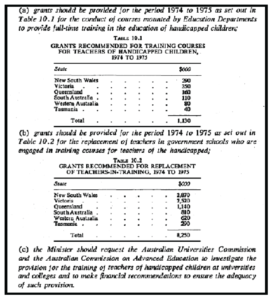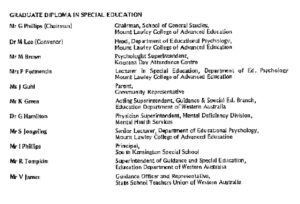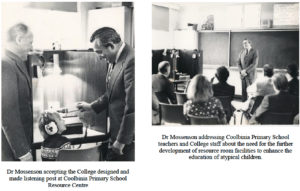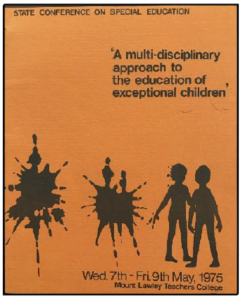Special Education
Background
Quality teaching for all children, irrespective of their physical or mental development was at the core of teacher education courses at the newly established Mount Lawley Teachers College. Consequently, the education of children with physical and mental disabilities also became a specific focus during the planning and implementation of teacher education courses. This was largely due to the drive and enthusiasm of three foundation staff members, the Principal Bob Peter, Mike Lee and Phil Smith.
At his previous teacher training college, the foundation principal, Bob Peter, had established a
Saturday morning special program for children needing extra tuition and he insisted that this would continue at his new institution. Mike Lee’s research and further study was in the education of exceptional children and was also involved in establishing the Dyslexia Association of Western Australia (1969). Mike had a powerful and influential role in developing course content leading to specialised undergraduate courses and eventually the establishment of the Graduate Diploma in Special Education in the mid-1970s. Phil Smith, Senior Lecturer in Education and Psychology, had been involved in running remedial reading programs at UWA and his expertise and encouragement led the way for specific course units and experiential programs for teacher education students interested in developing their skills in helping children with developmental learning problems.
All three were qualified in Psychology and saw the need for all teacher education students to receive some training in the education of atypical children, particularly after the monumental changes in education policy and direction during the 1960s in the USA, Europe and in Australia, where educators and parent groups began to question the quality of education provided to students with disabilities. The predominant model up to that time was based on a medical diagnosis of disability where children were classified as cerebral palsy, visual handicaps, emotionally disturbed, hearing deficiencies and intellectually disabled. It was thought that these children with the same disability were best taught within the same homogeneous groups, with the result that separate special schools or centres for the disability groups were established, and their teaching emphasis was on building skills which would support these children for living within the community.
With the publication of Bloom’s Taxonomy of Educational Objectives in 1956 the focus of teaching centred around clearly stated descriptions (objectives) on what students are expected to learn by the end of the course, written in such a format that the achievement of the objectives could be measured. This was picked up by the Neal Report on secondary education (1964) in Australia and again emphasised by the Dettman Report in Western Australia which stated that “… the aims of [secondary] education were to be expressed as behavioural objectives for all subjects taught and that the ‘evaluation of students should be made in terms of all these objectives’ in both the affective and cognitive domain”. Clearly stated behavioural objectives became an essential part of all courses developed at Mount Lawley Teachers College and students were required to implement this approach in their practical teaching lessons when on teaching practice in schools. This specifically applied to those students who elected to have teaching practice in special schools.
The publication of Wolfensberger’s concept of Normalisation in 1972, first applied to mentally retarded people in Scandinavia in the 1960’s, spread quickly to other fields of impairment in countries across the globe and became the drive to have children with various handicaps integrated into the education system and where possible into normal classrooms. Thus, the vision of integration of atypical children within the normal classroom was foreshadowed in the stated objectives of the units ML 215.1 and ML 315.1 The education of atypical children (teaching option). It stated “To provide future teachers of normal groups with the appropriate knowledge and techniques which will enable them to meet the educational needs of atypical children”. It is also interesting to note that the set text book for these units changed from a general “An introduction to educational psychology” to a specific text, Gagne’s “The conditions of learning” thus focusing on the educational needs of children and how best to achieve these, without the need to identify medically diagnosed subgroups of handicap. Thus the stage was set for the development of courses and programs emphasising specific behavioural objectives to be achieved and teaching methods of achieving these with all children, including atypical children either within the normal classroom or in special centres. This is the background to the history of Special Education courses at Mount Lawley.
A long and winding road toward a Graduate Diploma in Special Education
In 1971 on the newly completed first part of the Mount Lawley premises, a special child study unit was introduced which focused on the education of atypical (then referred to as handicapped) children. This gave a small number of students who selected this option an opportunity to work with children at the Nathanial Harper Home and also assist their teaching staff when children were at the Apex Camp at Point Perron. In 1972 the option course, Education of Atypical Children, was expanded and a Clinic in Remediation (originally proposed in 1970) was introduced to be held every Saturday morning, on-campus, and conducted by teacher education students, supervised by special education staff. This clinic was set up by the Head of Department Phil Smith and in July 1972 Brenda Buchanan was appointed as the principal coordinator. “There were two objectives of the Clinic: to offer interested students some experience of techniques in remediation; and to provide staff members with an opportunity of maintaining a practical concern with the teaching of primary school pupils”. The Education of Atypical Children course became a popular teaching option, but the numbers were limited due to lack of staff. As stated in the 1972 Annual report “Education of Atypical Children could be expanded if there were more staff to take groups”. The course put a modern focus on the teaching of atypical children. Professor Don Bear was invited to run “how to do it” workshops with staff and students on behaviour modification, to be implemented in programming and lesson design.
While the Education and Psychology staff at Mount Lawley were introducing modern psychological research findings and advanced educational philosophies into their teaching courses, especially the teaching of atypical children, on the national scene significant changes were foreshadowed. Late in 1972 the newly elected Whitlam government established an Interim Committee for the Australian Schools Commission, chaired by Peter Karmel. Its report “Schools in Australia” tabled in 1973 “identified many inequities in the funding system” which led to significant funds made available for education in general and special education in particular. Chapter 10 of the report identified the needs for early identification and intervention of atypical children and the provision of funds for the training of teachers. As stated in The Education Circular of the WA Department of Education (May, 1974) “Section 10.14 of the [Karmel] report recommends that ‘a minimum of one year full-time special training, in addition to basic training, should be provided for all teachers of handicapped children’ and that ‘ideally these courses should be undertaken in universities of advanced education’.
Special funding was available as reported in Section 10.17, page 113, which recommends that:

In response to the Karmel Report, a “committee under the joint chairmanship of Sybe Jongeling and Michael Lee prepared a submission for funds for both undergraduate and postgraduate courses in Special Education. The submission was approved and significant funding was made available in 1974 for undergraduate courses, the expansion of the College’s commitment to Special Education and the appointment of a specialist lecturer in Special Education.
On the initiative of Bob Peter:
The Principal concluded an agreement with the Director of Special Services of the State Education Department, Dr Neil Stewart, relating to the conduct of a full-time course in Special Education for about 35 serving teachers at the College in 1974. The Department will utilise Karmel moneys to finance and run the course; the College is to provide accommodation for the Project Head and his staff and all necessary teaching space facilities. College staff, especially members of the Department of Education and Psychology, will assist as required in the planning and teaching of the course. It is anticipated that the State Department of Education will be responsible for the course for two years after which consideration will be given to the assumption by the College of the major management and teaching function with the Department providing the course clients.
The initial response from serving teachers to the advertisement for the course for a year’s full-time training at Mount Lawley College resulted in 130 applications. Unfortunately funding restrictions and scarcity of replacement staff in special schools, only allowed 35 teachers to commence the course in 1974. This very popular course, Graduate Course in Special Education, was organised by the Guidance and Special Education Branch under the control of the Acting Superintendent Keith Green and under his direction ran for two years with 35 students till 1976, when the course was incorporated into the Colleges Special Education Program.
The successful application for Karmel funding to develop further initiatives in special education allowed the College to work with the Education Department of WA to setup a special resource centre at Coolbinia Primary School and also incorporate a Toy Lending Library to provide a range of toys and puzzles to be used at home by parents of children with learning difficulties. An extract from the Mount Lawley Teachers College Annual Report shows the aims, organisation and reasons for implementing the Resource Centre.

The resource centre was used as a support for children who needed some extra tuition. Individual children visited the centre as part of their regular classroom study and returned at the end of the lesson. Evaluation of results indicated significant improvement in students’ work. It became the envy of other students in their classrooms who thought that the selected students were lucky to go to the resource centre, and they also wanted to be part of that work.
Further Commonwealth funding was again made available to support the continuation and expansion of the College’s commitments to Special Education. The College received approval to prepare a building plan for a Special Education/Education/Psychology Centre to be submitted for action in 1975. Unfortunately the Federal Government in their budget 1975/76 decided to put a hold on all non-essential capital projects and that an Education Centre was not essential. Consequently, the Education/Psychology component of the plan had to be excised and a budget of $500,000 (significantly reduced from the original $922,000) was allocated to the building. However after the 1975 elections, a change of Government resulted in the project to be shelved.
During 1974, in the absence of Mike Lee, who was pursuing a PhD in Special Education in the USA, Sybe Jongeling and Laurie Summers developed a submission to the Western Australian Teacher Education Authority and the Tertiary Education Committee for a post graduate course leading to the award of Graduate Diploma in Special Education. The initial submission was accepted and during 1975 a full description of the proposed course, staff and facilities was further developed by the Acting Head of Department, Sybe Jongeling, ably supported by Laurie Summers and the newly appointed lecturer in Special Education, Patricia Formentin, whose knowledge and skills were invaluable in structuring the new course. As part of the approval process the College instituted a Course Advisory Committee comprising members of College staff, allied professionals and community representatives. Special education staff worked closely with members of the advisory committee to develop the final submission for the establishment of a Graduate Diploma in Special Education at Mount Lawley Teachers College. The specific qualifications and experience of staff and the wide range of skills by members of the advisory committee combined well in producing the final document.
Members of the Graduate Diploma in Special Education Committee
The proposed course still had to jump several hurdles. First it gained approval from the Australian Council of Awards in Advanced Education. Then the course was approved by the Commission on Advanced Education and finally it was endorsed on 16 June 1975 at a Special Meeting of the Advisory Committee of the Council of the Western Australian Teacher Education Authority for implementation in 1976. Refinement of the approved course content and the development of course structure and unit outlines during the second half of 1975 fell entirely in the hands of Laurie Summers, who was appointed as Head of Department when Sybe Jongeling went on Long Service Leave. Despite the fact that Laurie became the fourth head within five years, it shows that the Principal, Bob Peter, and staff of the Department of Education and Psychology worked closely together as a team and were determined to develop a much needed graduate course leading to a Graduate Diploma in Special Education. Fortunately the recently appointed Lecturer in Special Education, Patricia Formentin, assisted Laurie and she became an integral contributor to the final stages of the development of the program. Certainly it was a long and winding road from the early days of the establishment of the new College to the actual start of the course in 1976!
With the appointment of Patricia Formentin, the special education programs at the College oriented towards direct instruction, phonics and greater experiential opportunities of working with atypical children in a range of settings. Consequently, during 1975 further changes in the practicum for College students in the Special Education Option were introduced for them to be placed in special classes and centres for handicapped children and the College continued discussions with the Education Department to support a number of resource rooms, based on the Coolbinia model, to be developed in other centres. At the same time, the College also introduced Major studies In Special Education and Remedial Education. A “Special Education grant from the Commission on Advanced Education was utilised to expand and enrich College teaching and develop facilities in schools for the experiential aspects of the Special and Remedial Education units”.
 These funds were used to further support and enhance the educational resource room at Coolbinia Primary School and implement DISTAR programs in reading and mathematics for migrant children at Highgate and North Inglewood primary schools. During 1976 further funding was made available to expand the prototype resource rooms in a variety of special education settings within local primary schools. On October 20, 1976 the College presented the Coolbinia Resource Centre with a listening post comprising eight separate, individual booths for children to use. The structure was designed by Sybe Jongeling and built by the College maintenance staff. It was officially donated to the Coolbinia Resource Centre by the Principal, Mr R. G. Peter and accepted by Dr D. Mossenson, Director General of Education WA.
These funds were used to further support and enhance the educational resource room at Coolbinia Primary School and implement DISTAR programs in reading and mathematics for migrant children at Highgate and North Inglewood primary schools. During 1976 further funding was made available to expand the prototype resource rooms in a variety of special education settings within local primary schools. On October 20, 1976 the College presented the Coolbinia Resource Centre with a listening post comprising eight separate, individual booths for children to use. The structure was designed by Sybe Jongeling and built by the College maintenance staff. It was officially donated to the Coolbinia Resource Centre by the Principal, Mr R. G. Peter and accepted by Dr D. Mossenson, Director General of Education WA.
Meanwhile the Graduate Course in Special Education for serving teachers continued to be run at the College, by the Western Australian Education Department for 38 full-time teachers and supported by College staff. At the completion of the course, students were awarded the Certificate in Special Education. College staff contributed to the teaching program of the Graduate Course and worked well with the Coordinator, Keith Green, and his staff. 
 Students in this course, who were serving teachers in special schools, became well aware of the radical pro-active changes in the USA, England and Europe toward the teaching of atypical children, and the tendency of integrating these children in the normal classroom settings. College and Education Department funds made available under the Karmel funding for special education arrangements, were used to set up a Special Education Library and Resource Room holding the latest journals, text books and teaching material available across the world for use by special education staff and students. Undergraduate and postgraduate students were able to use these materials for their private studies or borrow them when going on their two-week teaching practice or on their 10-week Assistant Teacher program. In addition wooden puzzles, educational toys, learning materials, activity worksheets, journals and the latest text books were also made available to assist parents of disadvantaged children to help them enrich the learning process at home.
Students in this course, who were serving teachers in special schools, became well aware of the radical pro-active changes in the USA, England and Europe toward the teaching of atypical children, and the tendency of integrating these children in the normal classroom settings. College and Education Department funds made available under the Karmel funding for special education arrangements, were used to set up a Special Education Library and Resource Room holding the latest journals, text books and teaching material available across the world for use by special education staff and students. Undergraduate and postgraduate students were able to use these materials for their private studies or borrow them when going on their two-week teaching practice or on their 10-week Assistant Teacher program. In addition wooden puzzles, educational toys, learning materials, activity worksheets, journals and the latest text books were also made available to assist parents of disadvantaged children to help them enrich the learning process at home.
 Teaching programs and methods were changing toward meeting the needs of every child, no matter the medically diagnosed label attached. Teachers, parents, medical staff and allied professions wanted to hear from experts actively working in the field and translating the latest research findings into recommendations for classroom practices and materials. Thus, through this close working relationship with College staff, Keith Green and his students, the concept of a State Conference on Special Education emerged. The idea was enthusiastically endorsed by the Education Department of Western Australia, Independent Schools Association, Catholic Education Commission, all tertiary colleges and universities, Child Health Services, Mental Health Services, WA Teacher Education Authority, and the Department for Community Welfare.
Teaching programs and methods were changing toward meeting the needs of every child, no matter the medically diagnosed label attached. Teachers, parents, medical staff and allied professions wanted to hear from experts actively working in the field and translating the latest research findings into recommendations for classroom practices and materials. Thus, through this close working relationship with College staff, Keith Green and his students, the concept of a State Conference on Special Education emerged. The idea was enthusiastically endorsed by the Education Department of Western Australia, Independent Schools Association, Catholic Education Commission, all tertiary colleges and universities, Child Health Services, Mental Health Services, WA Teacher Education Authority, and the Department for Community Welfare.
A planning committee was formed with S. Jongeling as the Convenor; K. Green (Education Department of WA) and J. Jones (WA Institute of Technology) as Secretary; and Dr G. Amerson (Churchlands TC), Dr P. Cole (UWA) and Dr J. Henzell (School Health Sciences) as Members. The Committees deliberations were influenced by the following quote: (from the inside back cover of the Conference Program).

Dr Alex Maggs, Lecturer in Special Education, Macquarie University, NSW was invited as the principal speaker for the conference. He was supported by a generous grant from The Science Research Associates Pty. Ltd. The State Manager of S.R.A, Mr Brian Stinson supplied materials, advice and assistance with the arrangements for the Conference. Various local firms participated in the display of educational materials.
The focus for the Conference revolved around the theme “A multi-disciplinary approach to the education of exceptional children”. And the main objectives of the conference and workshops were:
- To develop an awareness of the needs and provisions of the Community for the exceptional child;
- To explore ways of translating research findings into recommendations for classroom practices and materials;
- To help educators to become acquainted with the wide variety of learning programs currently available.
The three-day Conference was opened by Mr K. Beazley, M.H.R., Federal Minister for Education and Dr W. Neal, Chairperson, Council for Special Education and attended by approximately 130 serving teachers and senior professional staff from government departments and tertiary institutions. Dr T. Parry, Senior Medical Officer, Child Health Services, WA, gave the Conference Address. Major topics for conference lectures and workshops during the three days included:
- An inquiry into understanding the needs of socially and culturally disadvantaged children;
- An evaluation of packaged educational programs available to the teacher of exceptional children;
- An examination of the social problems rising from mental retardation; and
- Learning and behavioural disorders: early identification and their consequences.
Lectures, panel discussions and workshops were presented by Dr Alex Maggs, Dr Trevor Parry, Dr Guy Hamilton, Dr Peter Chauvel, Dr Des Gurry, Dr Judith Henzell, and supported by medical practitioners, special education staff from all tertiary institutions in Western Australia, Mental Health Services, the Guidance and Special Education Branch of WA, Child Health Services, and Speech Pathology. Overall the conference was focused on the practical aspects of identifying and teaching children with mental, social and behavioural disorders. Discussions at time became quite vocal between some departmental administrators adhering to the old medical model, and professional teaching staff eager to explore the latest research outcomes of modern teaching techniques and available packaged educational programs of benefit to the classroom teacher. This State Conference on Special Education was very timely and encouraged all to reconsider their approach to making the best educational decisions to best teach children, irrespective of their medically assigned label.
An initial intake of 22 full-time teachers commenced the newly established Graduate Diploma in Special Education course in 1976. The course replaced the Education Department Graduate Certificate in Special Education and consequently it was necessary to also convene a committee to consider a “validation program” through which students who have completed the original Graduate Course in Special Education may satisfy requirements for the newly registered Graduate Diploma in Special Education. A submission was presented to the Investigation Panel which previously considered the College submission for the Graduate Diploma in Special Education. The validation program was accepted and proposed to be mounted in 1977 for some 50 graduates of the Certificate
in Special Education course.
Consolidation and refinement of the programs offered in Special Education from 1976 onward included new units in Special and Remedial Education to be offered in the Bachelor of Education degree commencing in 1977. The Graduate Diploma in Special Education course continued in strength and diversity in mode of presentation and from the initial intake of 22 FT, PT and External students the numbers rose to 51 in 1978, 67 students in 1979 and 78 students in 1980. Refinement and re-accreditation took place throughout the 70s and on the “recommendation of the visiting national accreditation panel a new core unit in studies in Literacy, Language and Numeracy was introduced in the course and some modifications were made to the teaching in the unit Remedial
Education. From its initial concept at the foundation of the College in 1970, the Graduate Diploma in Special Education has gone through a rigorous process of changes, refinements and accreditation phases to become a comprehensive course accredited by professional bodies, focused on the role and teaching techniques of practicing teachers, and well accepted by parents of atypical children.
It certainly was a long and winding road, but the effort was very worthwhile in focusing on the educational welfare of special children and not on their medical classification.

Extract of course outline from Mount Lawley Teachers College, Handbook 79, page 60.